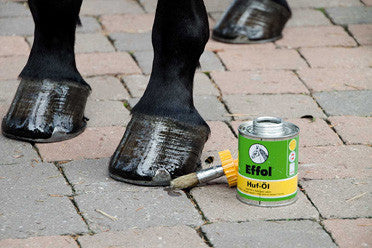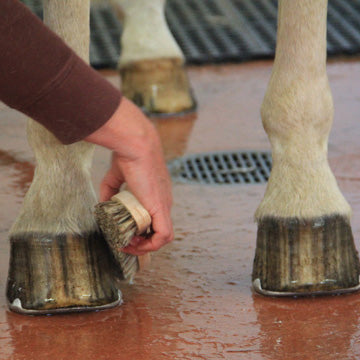How to Care for Your Horses' Hooves
 The old saying ‘no hoof no horse’ gains special significance in the winter, when elements, cold temperatures and wetness can contribute to hoof decay. Here in the Midwest, this is a big concern. In warmer climates, dryness and exposure to sand and rough terrain can also take a toll. Here a summary of factors that determine the condition of your horse's hooves:
The old saying ‘no hoof no horse’ gains special significance in the winter, when elements, cold temperatures and wetness can contribute to hoof decay. Here in the Midwest, this is a big concern. In warmer climates, dryness and exposure to sand and rough terrain can also take a toll. Here a summary of factors that determine the condition of your horse's hooves:
- Genetics
- Nutrition
- Trim
- Environment
- Exercise
With these variables, there is much we can do to support healthy hooves in our horses. But one solution does not fit all...
What is a hoof?

The horse’s hoof is the equivalent of the last two digits of the human middle finger, encapsulated by horn layers. When caring for our horse’s hoof, we are concerned with the outer layers: the wall, the sole, the frog, and also the coronary band.
The coronary band: The equivalent of our cuticles. This is where hoof growth starts.
The wall: The wall is between 5 and 10 mm thick and consists of three layers. The outer layer of dense horn acts as a barrier to the inner layers. If the outer layer is healthy and maintained properly, it prevents dehydration of the inner layers.
The sole: The sole can grow up to 10 mm thick. Its Keratin* is more easily worn down than that of the hoof wall.
The frog: Keratin in the frog and bulb is also softer than in the hoof wall. With every step, the horse’s weight expands the frog, which in turn presses the hoof wall outward. This is called the ‘hoof mechanism’, a healthy and necessary function of a natural hoof.
How a hoof stays healthy
With the three elements wall, sole and frog having distinct functions that interlace into one mechanism, there is a balance that we’d like to maintain:- The wall should stay hard and strong but resilient and not brittle.
- The sole should be dry and somewhat flexible, but not crumbling or too dry and hard (think expansion).
- The frog needs to be elastic and resilient but not soggy or rock hard to maintain a healthy hoof mechanism.
Caring for your horses' hooves to keep them healthy and resilient:
Step 1 - Determine the "Current State"
When striving to create and maintain a healthy hoof in our horse, it is first of all important to determine the current state:
- Is the hoof soft and brittle?
- Is the hoof hard and brittle?
- Is the hoof dry and rock-hard?
Then we can decide what measures to take to help our horse maintain a healthy hoof. (For more important external and internal factors that determine hoof health see below.)
Step 2 - Care for Your Horses' Hooves
Soft and brittle hooves
This is what is looks like: A soft brittle hoof will visibly disintegrate. Pieces of horn break of the hoof wall. The hoof is described as “crumbly”. If shod, the farrier will have a hard time keeping a shoe on this hoof.
Causes: Too much exposure to wetness without proper ‘barrier’. Exposure to manure/urine/wet bedding/mud. Hoof horn possibly genetically somewhat soft.
Repair: Avoid wetness! Dry bedding, dry lot without puddles. Clean hooves thoroughly with water and brush, dry with a towel, then treat hooves daily with a hoof oil.
Maintain: Keep horse’s environment dry and clean hooves daily. Treat several times per week with a natural hoof treatment.
Hard and brittle hooves
 A dry and brittle hoof with vertical cracks.
A dry and brittle hoof with vertical cracks.This is what it looks like: A hard and brittle hoof has lost its resilience and elasticity by allowing too much of the moisture of the inner layers to evaporate through the outer protective layer, mainly the hoof wall. It will show up as a hard, dry looking hoof with vertical cracks.
Causes: The outer layer of the hoof wall and sole does not act as a protective barrier and is stripped of its natural defenses. Harsh hoof treatments, harsh chemicals (shampoos, soaps), very dry environmental conditions, very cold environmental conditions. Hoof genetically predisposed to hardness/dryness meets unfavorable conditions.
Repair: A horse with a dry and brittle hoof can benefit from a bit more moisture. Standing in a puddle, hosing, soaking, spraying CLEAN bedding with a little water. Clean hoof daily with water and hoof brush, then dry thoroughly with a towel and apply a moisturizing, protective hoof conditioner (Preferably no petroleum-based products!). After the hoof condition has noticeably improved, switch to an all-around hoof ointment (I like Effol Classic Hoof Ointment).
Maintain: Clean and condition daily or at least several times per week to maintain the outer layer’s ability to lock in moisture. Monitor the hoof for signs of dryness and soak or hose when needed.
Dry and hard hooves
This is what it looks like: Dry and hard hooves (hooves like a ‘rock’) are often mistaken for healthy hooves. If you examine your horse’s hoof and the sole and frog present rock-hard and inflexible, this is–while it looks so clean and healthy–not a good thing when we think about the hoof mechanism. A healthy hoof mechanism requires a resilient and elastic frog and bulb and some elasticity in the sole and wall.
Causes: Horses with dry and rock-hard hooves are mostly kept in clean stalls, are shod, and generally well cared for. Genetics also play a role. That said, this is a clean, but not a healthy picture!
 Cleaning feet regularly is important.
Cleaning feet regularly is important.Repair: Evaluate the horse’s trim. Is the horse carrying weight on the hoof wall, the bars and the frog? If not, consult with your (or another...) farrier. A shod horse can still have a healthy hoof mechanism to some extent! If possible, apply a nourishing hoof conditioner on the clean hoof several times per day. Spray clean bedding with a little water. Once there is noticeably improvement, switch to a good-quality hoof oil (I like Effol Hoof Oil with Lanolin and Laurel Oil).
Once there is noticeably improvement, switch to a good-quality hoof oil (I like Effol Hoof Oil with Lanolin and Laurel Oil).
Maintenance: Clean hooves daily and apply a nourishing hoof oil several times per week. Soaking in water, standing in puddles, turnout in pasture and hosing can support hoof health for a hard and dry hoof.
Tips and Tricks
Soaking Hooves
To provide some moisture for dry hooves, cut a thick piece of felt in the shape of your horse’s hoof, soak it in water, place it in a horse boot (Easy Boot Trail, for example, or any therapeutic boot) and let the horse stand in it while you are grooming.
The low-tech version is to cut 4 pieces of an old wool blanket to size, big enough to wrap and tie around your horse’s feet. Soak in water, wrap and tie around your horse’s feet while grooming. (Be sure this doesn’t scare your horse and tie the pieces securely.)
Applying hoof oil
Laurel oil has been a staple in old-school hoof care for centuries and is ideal for the maintenance and to support growth of a healthy hoof. Massaging the oil into the coronary band and then down will improve the effect. You can use an old tooth brush to massage the oil into the hoof.
Hoof health from the inside
There are several internal factors that determine the horse’s hoof quality:
- Nutrition - Adequate nutrition, roughage, minerals/vitamins, balanced rations are crucial for healthy hoof growth.
- Genetics - Certain breeds tend to have certain types of hooves or typical hoof problems. Individuals also have their special genetic ‘hoof make-up’. Again, there is no one-for-all solution!
- Laminitic changes and other health factors - The insulin-resistant horse, the Cushings horse, a horse that has foundered in the past or is prone to laminitis is also a horse with possible hoof problems. Consult with your vet and farrier, care and hoof treatments can support your horse but not ‘fix’ the problem.
Hoof health from the outside
External factors determine your horse’s hoof health to a great extent. These are factors that you can control:
- Manure - manure disintegrates the outer layer of the hoof and can lead to brittle, cracking hooves or to fungal/bacterial conditions. Keep the horse’s environment as clean as possible.
- Trim/shoeing - consult with your farrier to determine the best possible trimming/shoeing solution for your horse. If your farrier applies a ‘one for all’ solution, look for a different farrier.
- Weather/environmental - While you cannot change the weather, you can change the way you maintain your horse’s hooves (above).
- Exercise - The ‘equine couch potato’ will have a hard time maintaining a healthy hoof. Adequate exercise is one of the important factors when it comes to healthy hoof growth.
Maintenance - Clean hooves and apply a conditioning hoof care treatment. This is the equivalent of using hand lotion, cuticle oil, hair conditioner, etc. It is not the ‘fix all’ but a necessary component of good care.
 A healthy hoof takes care.
A healthy hoof takes care.
Interested in EFFOL Hoof Care Products? Here is a handy visual to guide you to the right product:

As always, enjoy your horse!




